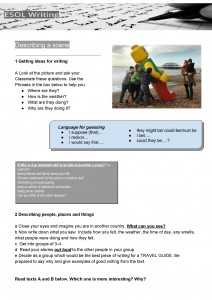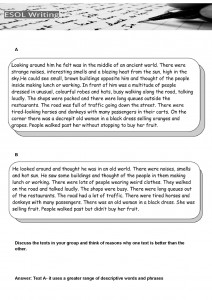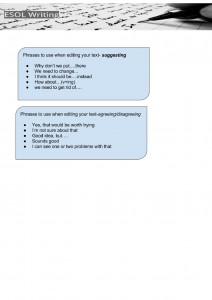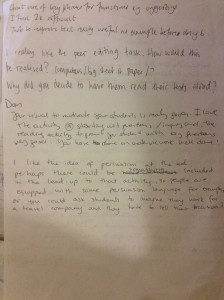For week 8 we were asked to make a worksheet. The criteria included:
- make with a specific group in mind
- Two to three sides
- based around a text (including visual, aural or multimedia text)
It needed to include all or any of the following:
visuals
• an aim/goal/objective for students
• the written text or a link to the audio/video clip
• a lead in
• a gist task
• a sequence of tasks to develop skills and/or
• a sequence of tasks focusing on a grammar point and/or
• a sequence of tasks focusing on lexis
• a record of any language taught on the worksheet
Materials can be informative (informing the learner about the target language), instructional (guiding the learner in practising the language), experiential (providing the learner with experience of the language in use), eliciting (encouraging the learner to use the language) and exploratory (helping the learner to make discoveries about the language). Tomlinson
As different learners learn in different ways (Oxford 2002) the ideal materials aim to provide all these ways of acquiring a language for the learners to experience and sometimes select from.
Most coursebooks are made with an explicit teaching practice in mind
Materials development has not been researched seriously until the mid 1990s
I made my worksheet with the following class in mind.
Learners- Adult ESOL Students at E3/B1/Intermediate level
Course/Class- second week of 12 week Writing course
Aims- ‘Describe a scene’ To plan, write, edit and improve a text using prepositional phrases, adjectives and descriptive phrases
Relating to previous learning- last week we looked at elements of successful writing and analysed a series of texts. In this lesson we are comparing two texts to decide which is better, using the criteria from last week.
Learner needs- as an ESOL course the emphasis is on practical requirements in writing- the scheme of work for week 2 lists filling in forms as the topic. However, I have decided to delay this as looking at the learners’ initial assessments I saw there was a lack of descriptive writing, varied sentences and planning. Also, the language we will use in the lesson can be recycled for personal statements, CVs etc.
Criteria for evaluation
When creating criteria for evaluation with Sherifa and Adriana most of them were specifically created to evaluate a coursebook. However we created some for overall evaluation, using Brian Tomlinson’s principles (pgs 8-23) as a starting point. As I think they are an excellent set of criteria I decided to use them to evaluate my own materials. They are listed below.
Do they prompt learners to ask questions?
Do they encourage the use of creative thinking?
Do they recycle previous language studied?
Are the activities created using recognised learning approaches?
Does the content encourage learner effort?
Do they provide exposure to authentic input?
Are there activities that focus on meaning as well as form?
Do they offer students choice? (of text, activity, extra work, variety)
Do the students get feedback on the effectiveness of their use of language (did they achieve a communicative goal)?
Other considerations
We have been talking about process writing in the staff-room and some great ideas from colleagues have found their way into my worksheet. As mentioned above I also wanted to develop learners’ general writing skills before focusing on specific writing types. Although this has given my worksheet a more EFL style than ESOL I believe this is beneficial to the learners at this stage.
The worksheet





Entry 3 Writing 2016 Describingascene
Evaluation of worksheet based on criteria
Do they prompt learners to ask questions?
Learners are asked to consider the value of the exercise in relation to real-life needs
They are asked to compare texts and consider which is better and why
Do they encourage the use of creative thinking?
They are asked to imagine a scene and describe it
They are asked to create a text that would persuade people to visit somewhere
They are asked to give reasons why they prefer one text to another
Do they recycle previous language studied?
Language of suggesting has been used before
They are asked to analyse text using criteria for succssful writing which was studied in previous lesson
Are the activities created using recognised learning approaches?
Process writing is a recognised learning approach
Task-based learning also used
Does the content encourage learner effort?
Learners asked to analyse two texts and decide which is better
Learners are asked to find examples of language use and analyse for grammar type
They are asked to find meaning of adjectives via each other or dictionary
Do they provide exposure to authentic input?
Lead-in photo is authentic
Functional phrases are used in everyday life ( ‘I reckon’, ‘I bet’)
adjectives are taken from real travel guides
Are there activities that focus on meaning as well as form?
Main task is designed to focus on authentic text- a travel guide- and purpose is to be positively descriptive, task-based learning
Do they offer students choice? (of text, activity, extra work, variety)
Little, in first task learners can choose any scene to describe
Do the students get feedback on the effectiveness of their use of language (did they achieve a communicative goal)?
Yes-first and final writing task is assessed for it’s communicative skill, not accuracy
Reflections on criteria evaluation
I am very happy with the evaluation as I have been able to cover most criteria. The glaring omission is the offer of choice to learners.
FEEDBACK FROM PEERS
What people liked
Looks appealing
Challenging
asking learners why skills practised are useful
opportunities for personalisation
use of key functional phrases
improving text task
example text
lead-in visual
Queries
reading aloud activity ( too soon, too personal)
staging process (more needed to support writing before it is shared)
To respond to the queries the reading aloud activity is essential for these reasons: learners may have difficulty reading each others handwriting, reading the text aloud allows the learners to add tone and emphasis to support understanding. It encourages motivation to write for an audience and supports pronunciation practice. It also allows them to understand themselves how clear their writing is. Also the whole point of the lesson is to look at how to edit and improve an initial text. By supporting and developing it at this stage would take away the process of group writing.
However, in acknowledgement it would be a good idea to inform learners that they will be reading their texts out loud before they start writing so that they will know this is going to happen. I also agree to a certain extent about more scaffolding for the first writing task. When used in a lesson more work was done on what could be written about in the text, for example describing senses- I used the photo on the worksheet to elicit sounds, smells, tastes etc. and I also emphasised that it didn’t need to be a real place.
Issues with worksheet design for evaluation
The problem with this type of task is to assess its value in terms of being a realistic reflection of the majority of materials designed for classroom use. When materials are being observed or analysed, as in for a formal inspection, a lot more time and effort is spent on their production. This obviously means that the teacher is thinking more carefully than usual about their materials but it also means that it is not a true reflection of what that teacher regularly uses.
Another point is that this amount of time spent on materials can actually have a detrimental effect on their quality. When being inspected or observed teachers are required to show they are including all the requirements set by the evaluator. This can result in a lesson that, although it may include a wide range of learning techniques, is constrained, artificial and unsatisfactory for teacher and learner. In having to evidence requirements in this way means that teachers cannot deviate from the script of the lesson plan, or respond to learner need. In creating my worksheet I felt this pressure to include different ‘essential’ elements meant that it became somewhat linear and over-reliant on instructions. This impacted on the layout, making it somewhat cramped, and meant that learners would be able to read later activities. This has given me an important insight into the creation of coursebook materials. My major criticism of them has always been the cramped style and over-use of instructions, various language points (Scott Thornbury’s ‘grammar McNuggets’) and linear style of exercises. I can see now how this can happen when the materials writer is attempting to make the activities explicit to the learner and also include a wide range of skills and language practice.
The solution is of course to ‘pull the material off the page’ and use it in your own way.
References
Matsuda, P.K., & Cox, M. (2011). Reading an ESL writer’s text. Studies in Self-Access Learning Journal, 2(1), 4 – 14.











